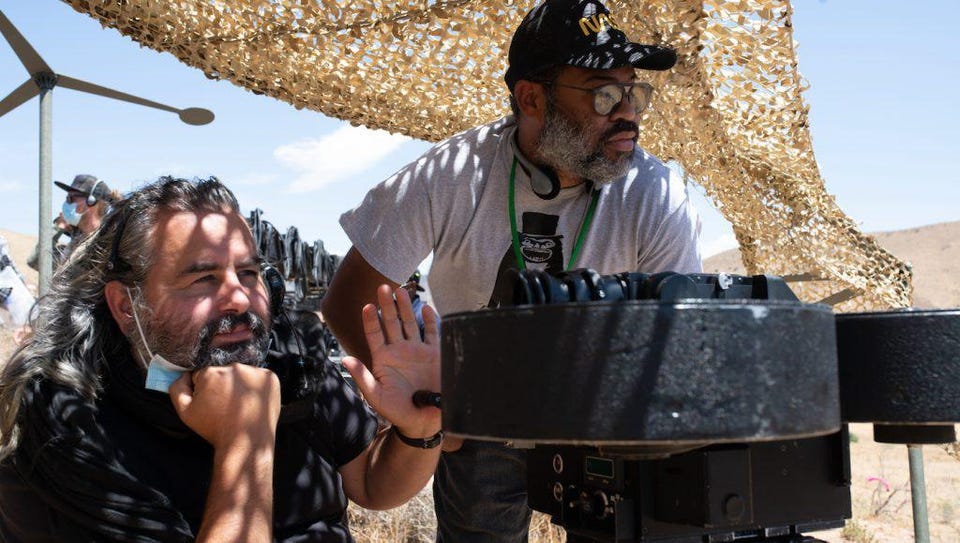Consumer Tech IMAX Next-Gen Film Cameras To Be Smaller, Lighter And Quieter Benny Har-Even Contributor Opinions expressed by Forbes Contributors are their own. I write about commercial cinema technology and smart-home tech. New! Follow this author to stay notified about their latest stories.
Got it! Aug 31, 2022, 05:33pm EDT | New! Click on the conversation bubble to join the conversation Got it! Share to Facebook Share to Twitter Share to Linkedin I’ve seen Jordan’s Peele’s Nope twice now and it’s a film that’s still gnawing its way around my brain, which is just the sort of unpleasant image that seems appropriate for a film as complex as this. It’s not a film that has proved contentious, but it is one that everyone has a reaction to, one way or another, which is the mark of an interesting film. As we’ve seen with his previous films Get Out and Us , Peele is a director who knows how to create mood and tension but with Nope he’s added another element – scale.
That comes from his use of IMAX cameras to capture the imposing mountain region around the outskirts of Hollywood where a mysterious object is lurking in the clouds. This is the first time that Peele has used IMAX cameras and it’s safe to say that he’s now a fan. So much so that he’s now working with IMAX on creating a number of next-generation IMAX film cameras.
In a recent conversation, with its head of post-production Bruce Markoe, told me that: “what we’re doing with these new cameras is to engage with some of the filmmakers who have worked with us and shot with our film cameras before – with directors, with directors of photography – and have got their feedback. What they liked, what they didn’t like, and how we could improve them. ” Hoyte van Hoytema and Jordan Peele filming Nope Glen Wilson/Universal Pictures IMAX cameras offer outstanding image quality but are known for being large, heavy and noisy.
It’s no surprise then that these are exactly the areas that IMAX is focusing on improving. What’s exciting about this from a filmmaking perspective is that if IMAX is able to deliver of these features, it will make for IMAX sequences with a different feel. Directors will be able to use them for more intimate, personal moments, not just for big, noisy action sequences.
Markoe wouldn’t commit to an arrival date for the cameras though saying that the engineering guys would hate it if he did! “It’s the prototype that takes the longest [to build] and, actually, once that’s done, built and approved, it will be faster to build the actual production models. ” MORE FOR YOU Google Issues Warning For 2 Billion Chrome Users Forget The MacBook Pro, Apple Has Bigger Plans Google Discounts Pixel 6, Nest & Pixel Buds In Limited-Time Sale Event He can commit to the number they are building, which is four. The new cameras will be in addition to the existing fleet, which means there will be 12 IMAX film cameras in total, which should be enough to enable two IMAX productions to take place at the same time.
It was during the production clash of Christopher Nolan’s Tenet and No Time to Die that the company realized it needed more cameras. With his long association with IMAX, it’s no surprise that Nolan got first dibs, with Cary Joji Fukunaga having to scale back its IMAX sequences due to the lack of cameras. What’s also heartening is the commitment to photographing on film, even when projection is almost entirely digital these days.
While it’s natural to assume that the reason is the cost and practicality – it turns out it’s actually one of scheduling. “It takes a lot longer to make film prints than digital,” reveals Marko. “The workflow and process to completing the movie and making the film prints takes quite a bit of time compared to a finishing a movie digitally.
Some are literally finished two weeks before they open in a theater, whereas if you want to make film prints you have to finish quite a bit sooner – 10 to 12 weeks before release at a minimum. That’s hard for some filmmakers. ” Even without film projection more film cameras, means more films that take advantage of the full frame IMAX 1.
43:1 aspect ratio but here in the UK, there is only one single screen that can cater for that: at the Vue Manchester Printworks, which has both an IMAX 1. 43 screen and a dual laser projector that can fill the screen. There are rumors that London’s BFI IMAX might also be joining the Printworks with that capability, but sadly Markoe was not able to confirm this.
However, with both Dune: Part 2 and Oppenheimer both likely to be IMAX 1. 43 productions, I very much hope that it happens. Follow me on Twitter .
Benny Har-Even Editorial Standards Print Reprints & Permissions.
From: forbes
URL: https://www.forbes.com/sites/bennyhareven/2022/08/31/imax-next-gen-film-cameras-to-be-smaller-lighter-and-quieter/



